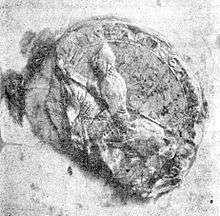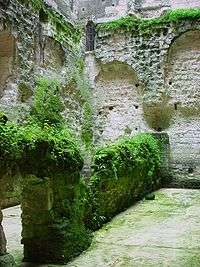Fulk III, Count of Anjou
| Foulque III, Count of Anjou | |
|---|---|
 Seal of Foulque III | |
| Spouse(s) |
Elisabeth of Vendôme Hildegarde of Sundgau |
| Noble family | House of Ingelger |
| Father | Geoffrey I, Count of Anjou |
| Mother | Adelaide of Vermandois |
| Born | 970 |
| Died |
21 June 1040 Metz |
Foulque III of Anjou (French: Foulques; British: "Fulk"), called Foulque Nerra ("the black"), was an early medieval Count of Anjou, and was one of the first great builders of castles. He lived from 970 to 1040, constructed an estimated 100 castles and abbeys across the Loire Valley in today’s France, fought successive wars with neighbors in Brittany, Blois, Poitou and Aquitaine and traveled four times to Jerusalem on pilgrimage during the course of his life. He had two wives and three children.
He was a natural horseman and a fearsome warrior, with a keen sense of military strategy that saw him get the better of most of his opponents. He was allied with the goals and aims of the Capetians against the dissipated Carolingians of his era. With his county seat at Angers, Foulque’s bitter enemy was Eudes II of Blois, his neighbor 128 km east along the Loire River, at Tours. The two men traded towns, followers and insults throughout their lives.
Foulque finished his first castle at Langeais, 104 km east of Angers, on the banks of the Loire, in 994.[1] Like many of his constructions, it began as a wooden tower, and was eventually replaced with a stone structure, fortified with exterior walls, and equipped with a thick-walled tower called a donjon in French (source of the English dungeon, which however implies a cellar, rather than a tower). He built it in the territory of Eudes I, Count of Blois, and they fought a battle over it in 994. But Eudes I died of a sudden illness, and his son and successor, Eudes II, did not manage to evict him.
Foulque continued building more towers in a slow encirclement of Tours: Montbazon, Montrésor, Mirebeau, Montrichard, Loches, and even the tower of Montboyau, erected just across the Loire from Tours in 1016. He also fortified the castles at Angers, Amboise, Chateau-Gontier, Chinon, Mayenne and Semblançay, among many others. “The construction of castles for the purpose of extending a ruler’s power was part of Fulk Nerra’s strategy,” wrote Peter Fraser Purton, in A History of Medieval Siege, c. 450-1220.
Foulque was also a devout Christian, and built, enlarged or endowed several abbeys and monasteries, such as the Abbey of Beaulieu-les-Loches, Saint-Florent-le-Vieil, Saint-Aubin, and a convent, Notre Dame de la Charité at Ronceray in Angers. Although he never learned to write, he endowed a school with revenue to provide poor students with an education. Foulque also undertook four pilgrimages to Jerusalem.
Family
He was the son of Geoffrey I of Anjou, also known as Geoffrey Grisegonelle, and Adélaide of Vermandois.[2] He had an older sister: Hermengarde (b. 960), who married Conan of Brittany and a younger brother Geoffrey.[2] A half-brother, Maurice, was born in 980.[3]
Foulque married Elisabeth de Vendôme (~979-999), daughter of Count Bouchard of Vendome,[4] and they had a daughter:
- Adèle.,[2] married Bodon, son of Landry, count of Nevers. Their eldest son, Bouchard, inherited Vendôme.
Elisabeth’s death was recounted in the Chronicles of Saint-Florent: Elisabeth occupied the citadel at Anger with some supporter and while under siege from Foulque, she suffered a fall from a great height, and then was burnt at the stake for adultery.[5]
Foulque married Hildegarde de Sundgau, whose family was from Lorraine, around December 1005.[6] They had two children:
- Geoffroy, in 1006,[7] who became known as Geoffroy Martel, succeeded Foulque as count of Anjou in 1040.[8]
- Ermengarde-Blanche, around 1018.[2] Geoffroy, who became known as Geoffroy Martel, succeeded Foulque as count of Anjou in 1040.[8]
Combat
Foulque Nerra’s first victory was in June 992 at Battle of Conquereuil, where he managed to defeat Conan I, duke of Brittany. Conan’s territorial ambitions had been quashed by Geoffroy Grisgonelle in 980, and seven years later, he planned an ambush on Angers while Foulque was at the crowning of Robert the Pious. Foulque and his men foiled the ambush, killing Conan’s son, Alain, in the process. In 992 Foulque laid siege to Conan’s castle at Nantes, but he slipped away to Conquereuil. Conan was killed in the battle, and Foulque set up as governor a regent, as the succeeding count was a child.
While Foulque and Eudes II fought many skirmishes over territory and alliances, their biggest battle occurred in July 1016 at Battle of Pontlevoy. Eudes was marching a large troop of 10,000 men southward toward Foulque’s tower at Montboyau when Foulque and a much smaller group attacked him from behind. Foulque’s men were routed, and retreated, and Eudes, thinking the battle won, went for a swim in the Cher River. Reinforcements arrived to help Foulque, and they returned and slaughtered Eudes' men, who were then at rest. Several thousand were reported killed.[9]
Pilgrimages
Foulque also undertook four pilgrimages to Jerusalem, seeking forgiveness for his sins in at least two of the journeys. Foulque Nerra travelled to Jerusalem for his first pilgrimage in 1003, a few years after his wife Elisabeth’s death but at a moment of calm along the route. The journey was across the Alps at the Grand Bernard Pass in today’s Switzerland, over land to Bari in the southern Italian peninsula (a stop in Rome was usually made), by ship to the Holy Land. The travel took as long as six months, through deeply dangerous territory.[10]
Foulque made a second pilgrimage in 1008, obliged to do so by the king as punishment after Foulque ordered the murder of an enemy. For his third and fourth trips, Foulque determined he had an moral obligation to protect pilgrims in the years following the desecration of Jerusalem by the Mad Caliph, so had his armed entourage provide security against robbers, murderers and enslavers along the route. His third trip was in 1035, with Robert I, Duke of Normandy, and then a fourth pilgrimage was made in 1038. He died in Metz in 1040 on his return from that trip, and was buried in the chapel of his monastery at Beaulieu.

Succession
Geoffroy Martel was count of Anjou from 1040 to 1060, but had no children from either of two marriages. The Anjou title went to his nephews, the two sons of his sister Ermengarde-Blanche (m. Geoffroy V of Château-Landon). Geoffroy III Le Barbu (the Bearded) was count of Anjou from 1060 to 1098; Foulques IV Le Réchin (the Mouth) was count from 1098 to 1109. Le Réchin's grandson, Geoffrey Plantagenet, married Matilda, heir to the English throne, and began the House of Plantagenet line of English kings.
Notes
- ↑ Kennedy 1995, p. 12.
- 1 2 3 4 Bachrach 1993, p. 262.
- ↑ Bachrach 1993, p. 14.
- ↑ Bachrach 1993, p. 16.
- ↑ Bachrach 1993, p. 76.
- ↑ Bachrach 1993, p. 100.
- ↑ Bachrach 1993, p. 102-103.
- 1 2 Bachrach 1993, p. 253.
- ↑ [Christian Thevenot, Foulque Nerra, Editions Alan Sutton, St. Cyr-sur-Loire, 2009]
- ↑ [Jonathan Sumption, The Age of Pilgrimage, The Medieval Journey to God, Paulist Press, 2003]
Further reading
- Bachrach, Bernard S. (1993). Fulk Nerra, the Neo-Roman Consul, 987–1040. University of California Press.
- Kennedy, Hugh (1995). Crusader Castles. Cambridge University Press.
| Preceded by Geoffrey Grisegonelle |
Count of Anjou 987–1040 |
Succeeded by Geoffrey Martel |
|